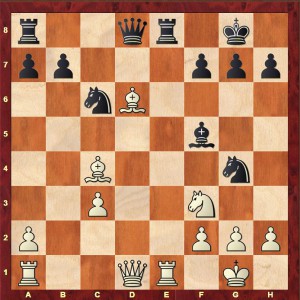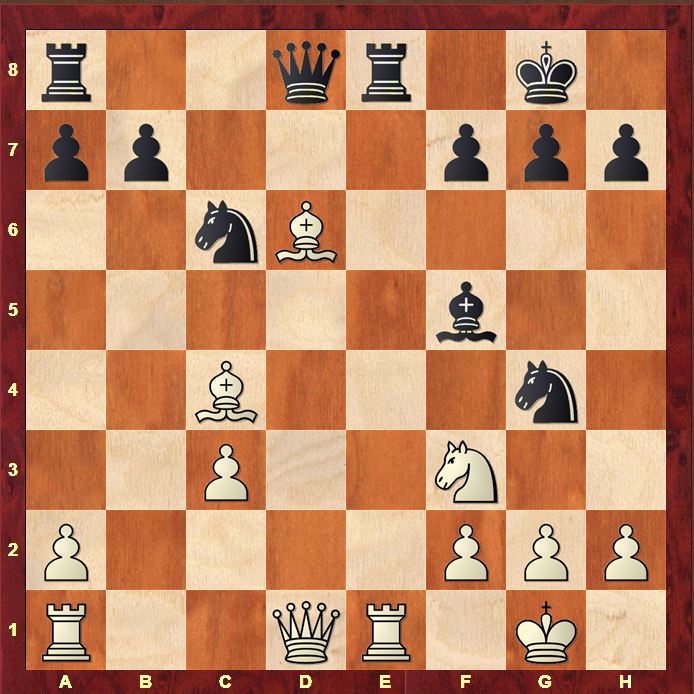I’ve recently been going through Alekhine’s Collection of Best Games (in the Kindle edition otherwise known as the world’s most complete collection of chess misprints) and stopping whenever a game grabs my attention. I got caught up for a few days by the game Alekhine-Isakov played in 1919, It features a very interesting attack in which – as always – a number of discoveries could still be made! The attack starts after Black’s 13th move (13…Bf5)

Here Alekhine started a sudden and dangerous attack:
14.Bxf7+ Kxf7 15.Qd5+ Kf6
This is the first point of the attack. The king must go to f6 as 15…Kg6 loses to 16.Rxe8 Qxe8 17.Nh4+. The king is very badly-placed now and gets in the way of his knight on g4 which White tries to exploit immediately.
16.h3
The crucial juncture at which Black has 3 possible continuations. We’ll start with the move played in the game: 16…Be6
A.16…Be6
Here Alekhine played 17.Qd2 but White has a more forcing continuation that occurred to me pretty much immediately. Strangely enough, I haven’t seen it mentioned anywhere
17.Rxe6+ Rxe6 18.Qg5+ Kf7 19.Qf5+
This is a typical mechanism in White’s attack in this game: he uses checks with the queen to both misplace the Black king and free attacking squares for his other pieces with tempo (in particular the knight) Here Qf5+ frees g5 for the White knight on f3. By the same token, the simple 17.Qg5+ (instead of 17.Rxe6) Kf7 18.Qf4+ (freeing g5 with a check again for the White knight) would also have been much better for White.
19…Qf6
19…Nf6 20.Ng5+
19…Rf6 20.Qd5+ Again one of those aimless-looking checks! (20.Ng5+ Ke8 wasn’t clear) 20…Ke8 (20…Kg6 21.Qe4+ Stockfish’s choice. (21.Nh4+ Kh6 22.hxg4 g5 23.Nf5+ was my line and is also very strong) 21…Kh6 22.Bf4+) 21.Re1+ Nge5 22.Nxe5
20.Ng5+ Ke8
20…Kg8 21.Qxh7#
21.Nxe6
The key tactic!
21…Qxf5 22.Nxg7+ Kf7 23.Nxf5 leaves White 2 pawns up
B. 16…Nh6
As the intermediate move 16…Be6 doesn’t seem to work, Black should examine the immediate retreat of the knight.
17.g4
Just as Alekhine did in the game
17…Be6
Now 18.Qd2 would transpose back to the game which was also very strong, but via this move order I think that White has an even stronger continuation.
18.g5+ Kf7 19.g6+
A similar theme to the queen checks in the variation after 16…Be6. A White piece checks to misplace the Black king and then frees g5 for the knight to enter!
19…Kg8
19…Kf6 20.Qg5#
19…hxg6 20.Ng5+ Kg8 21.Rxe6
19…Kxg6 20.Rxe6+ Rxe6 21.Qxe6+ Qf6 22.Qe4+ Kh5 23.Kh1 (Credit to Stockfish! I’d seen this idea, but I got it a little wrong in my head. I wanted to play 23.Qd5+ Kg6 24.Kh1, but 23…Qf5 is much better of course) 23…Qxd6 24.Rg1 Qf6 25.h4 is very neat as Black cannot stop Rg5+ in any sensible way
20.Rxe6 Rxe6 21.Qxe6+ Kh8 with a clear advantage for White though Black is still surviving (just!)
C. 16…Qa5
This is a suggestion of John Nunn’s and looks to be the most challenging defence. Funnily enough, I’d considered it but only after first 16…Nh6 17.g4 and now 17…Qa5. Here 18.Be5+ wins immediately as 18…Rxe5 19.g5+ is a gorgeous little intermezzo! 19…Ke7 20.Qxa5 Nxa5 21.Rxe5 wins as does 19…Kg6 20.Nxe5+ Kxg5 21.Qg2+ Kf6 22.Nxc6. And no, I didn’t spot that last one on my own – I needed Stockfish for that!
17.Bc5
I was very pleased when I found this idea. John Nunn only considers 17.Qxa5 which I thought might be an edge for White but Stockfish considers it dead equal.
17…Nh6
17…Nge5 18.Nxe5 Rxe5 19.Rxe5 Nxe5 20.Be7+ One of those weird tactical points: you use the bishop on c5 to block off the queen on a5 and then later exploit a discovered attack!
17…Rad8 18.Bd4+ Kg6 19.Qxa5 Nxa5 20.hxg4 Bxg4 21.Ne5+ is really strong as well
18.g4 Rad8
My main line
18…Qxc3 I found this a tough nut to crack. 19.Qd6+ Stockfish (19.g5+ Kg6 20.gxh6 was my line. It’s better for White but not the best) 19…Kf7 20.Qc7+ Kg8 21.Bd4 Wins! Astonishing!
19.Bd4+
Again exploiting the fact that the knight on c6 is defending the queen on a5
19…Kg6
19…Nxd4 20.g5+ (20.Qxa5 Nxf3+ is fine for Black) 20…Kg6 21.Nh4+ Kxg5 22.Qxa5 Nc6 23.Nf3+ Kf4 24.Qc7+ Kxf3 25.Qg3# was my line and gets the Stockfish seal of approval!
20.Nh4+
Stockfish finds the kill
20.gxf5+ was my line. 20…Kh5 (20…Nxf5 21.Re6+ Kh5 22.Qe4 wins) 21.Qxa5 Nxa5 22.f6 I thought this would be a nice advantage for White. Correct, but there is better!
20…Kg5 21.f4+
21…Kxf4 22.Rf1+ Kg5 23.Qxa5 Nxa5 24.Nxf5 Nc6 25.Be3+ wins
So does Black have any better? Well if you have any experience analysing with computers, then one defensive idea will pop up into your head straightaway: 16…Qa5 17.Bc5 Qd8! And very soon after that the thought 18.Bd6 Qa5 19.Bc5 Qd8 hug-hug, kiss-kiss, draw agreed! But we have more than that!
17.Bc5 Qd8 18.Qc4
This looked pretty good to me and the engines are all very happy with White’s prospects too.
18…Nh6
18…Nge5 19.Nxe5 Nxe5 (19…Rxe5 20.Rxe5 Nxe5 21.Bd4) 20.Bd4 followed by f4 leaves White a pawn up with Black’s king exposed
19.Be3 Rxe3
19…Qd3 20.Qb3 b6 21.Rad1 is also good for White
20.Rxe3 is a clear advantage according to Stockfish.
So it just remains to show how Alekhine finished things off! It was maybe a little less forcing, but still very powerful!
16.h3 Be6 17.Qd2 Nh6 18.g4 g6 19.g5+ Kf7 20.gxh6 Qf6 21.Ng5+ Kg8 22.f4 Rad8 23.Rad1 Bc4 24.Be7
24…Rxd2 25.Bxf6 Rxe1+ 26.Rxe1 Bf7 27.Ne4 Rxa2 28.Bg7 Bb3 29.Nf6+ Kf7 30.Nxh7
1–0
Another great attack from Alekhine!




1 Comment on “Attacking with Alekhine”